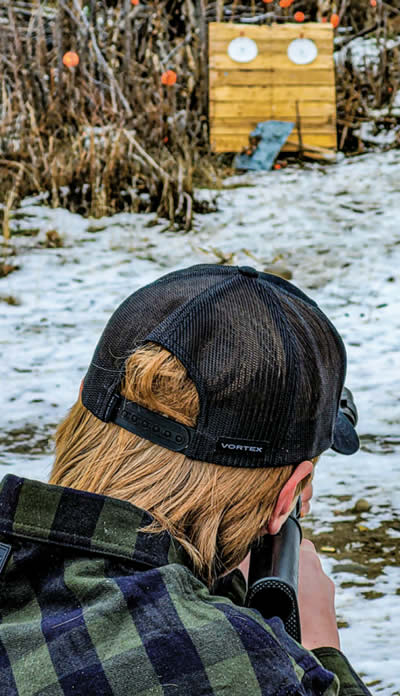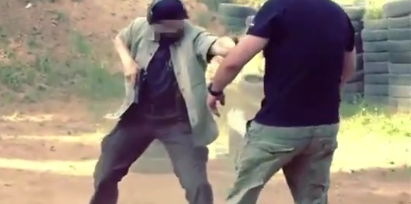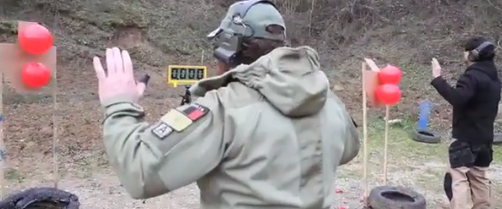
Plink to Become a Better Shot
Target shooting is not only fun and challenging, but a great way to correct bad habits, become more comfortable with full-size firearms, practice trigger control and more.
Story and Photos by Jason Brooks
plinking fun and a great way to learn the AR
platform for a fraction of the cost, thanks to the
fact the rifle is chambered in .22 LR.
Standing at the gun counter in my favorite sporting goods store and looking over the various rifles, I couldn’t help but notice the guy next to me purchasing a new rifle. It was a beautiful piece of art that made me jealous. This rifle not only had a select wood stock but the pencil-thin and blued barrel intrigued me a bit, so I asked him what caliber it was in. I was a bit shocked when he said, “.22 Long Rifle.”
I had to ask why he would spend so much money on buying a full-size and beautiful rifle in a “kids’ caliber.” It was his reply that got me thinking: “It’s much cheaper to shoot and I can find ammo; besides, it will teach my kids how to shoot better when they finally get old enough to shoot other rifles.”
That made sense and soon afterward I, too, purchased a new rifle in .22 LR. My rifle was the Smith & Wesson M&P 15-22, as I wanted to get into the “AR world” and teach my boys how to shoot these great rifles, but in a more cost-effective way. At around $500 for a case of 5.56 NATO vs. about $80 for 1,000 rounds of .22 LR, it only made sense to get the 15-22 as a learning tool. This rifle mimicked those same semiauto rifles that shoot the NATO rounds, from the charging handle, forend, stock and even the trigger.
The only difference was in the round it fired; the much more economical “plinker” rifle also meant more time at the range.
When it comes to accuracy, we can all look back to the very first time we ever shot a firearm, or even
a BB gun or pellet gun. It is all the same mechanics. Unfortunately for some, this was also a time when
we developed awfully bad habits. Flinching is often an involuntary reaction in our “fight or flight” reflex,
something that is extremely hard to overcome without a lot of practice.
There are several reasons that cause a shooter to flinch, but once it is deep-rooted in our experiences, it can be hard to correct. Shooting a firearm that has too much power for the shooter can cause a flinch, as can loud noises. Another cause of flinching is simply fearing the firearm; often this occurs when we are young or inexperienced.

distances, which makes plinking more fun and offers a challenge.
BY SHOOTING, OR better yet “plinking,” you can correct a lot of your bad habits, even flinching. The
idea of plinking is to go to the range and just shoot, a lot. Making it fun and enjoyable is the goal of the day, and this is why when we were younger we would take our pellet guns or .22s and shoot at various targets like tin cans and bottles. It was fun and that is still the key, but now it is time to put plinking to practice and become a better shot.
Set up the firearm, either a small caliber like a .22 LR or even a pellet gun, to be as similar to your primary
firearm as possible. For example, the Remington Model 547 that the guy was buying in the gun store is nearly identical in feel to the Model 700.
There are various rifles and handguns that model after their full-size, larger-caliber cousins. You can get a BB gun that is identical in weight and feel to a Beretta 92F, or buy a firearm like the M&P 15-22 to become proficient in working and shooting an AR platform.
Back to BB and pellet guns, one of the best benefits they offer is backyard shooting. This means setting up a range in the backyard and plinking all day, without the worry of driving to a range and dealing with those around you who are shooting their own firearms. When it comes to teaching new shooters, the isolation and familiarity of the backyard range is hard to beat. Nobody is staring at you and making their own “expert” comments. Once you pick the firearm you want, the next step is setting it up for success. The idea of plinking to become a better shot means trying to imitate the firearm you plan on primarily shooting. For the hunter, this is often a scoped rifle; for home defense, it might be a handgun with
a red-dot sight. Either way, try to set up the practice firearm to those same specifications.
Both of my boys have pellet guns that sport scopes. This helped them learn how to shoot with a scope,
taking their time and instead of just trying to hit the pop can, trying to hit a specific letter on the logo. It became a competition to them to see who could shoot out the bull’s-eye first, like the old carnival arcade game where you had to shoot out the star to win.
Without even knowing it, they were learning how to use a scoped firearm and hold it steady.
When it comes to open sights, plinking is a great way to learn and control sight alignment. The more times you practice, the better you will become, and shooting a small caliber means you can see the rounds hit the target as you fire, all the while concentrating on the front sight.
One drill to use is to mentally say to yourself, “Front sight, front sight” repeatedly while shooting. Put a small dot on the target and shoot it as many times as you can until you miss it. Then start all over again with another dot. Trigger control is one of the most important factors when it comes to accurate shooting. Plinking is just that: squeezing the trigger and aiming, while trying to hit the target multiple times. If you can find a firearm that has the same or at least a similar trigger to that of your primary weapon, then that is a bonus, but anytime you learn “how” to squeeze a trigger, the better shot you will become. With plinking you can take your time and shoot a lot of rounds.
Concentrate on feeling the trigger and ask yourself, “Is there any creep? When will it go bang? Did I pull the trigger straight back or did I push on its side and cause the gun to rotate? Did I push the gun forward and cause the gun to drop?” All of this can be worked on while plinking.
ONCE YOU SPEND a bit of time plinking at various targets and concentrating on the basics, you can
increase your skill set by adding in other targets. A moving target is always fun to plink at, so if your range allows it, set one up. Reset targets are also a great way to learn accuracy, as they are designed to reset when you hit the last gong so you can do it all over again. A cheap and fun way to plink
is to use balloons. You can blow them up to various sizes and put them on cheap wooden dowels and place them at different distances. This also works for the air gun shooter in the backyard. If a breeze starts to blow, then it adds to the challenge. Of course there are the old standby targets like water jugs and tin cans. You can also buy a case of clay pigeons for a few dollars and place them at various distances. The best part of using clay pigeons is that they break down and are biodegradable, so
at the end of the day it is easier to clean up the range.
A few years ago, my youngest son was working at a pumpkin farm and at the end of the season they had
a bunch of leftover pumpkins. We loaded up the truck and headed to the woods, where we set up a makeshift target range. Shooting pumpkins is a lot of fun and, again, they are biodegradable. You get the idea – make a range that is fun to shoot, not just a piece of paper with various circles on it. The more you plink, the better shot you will become.






